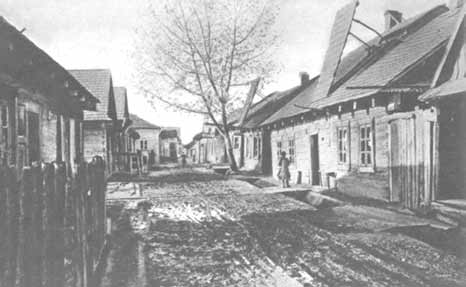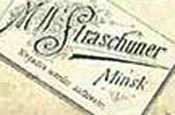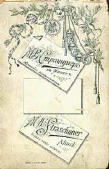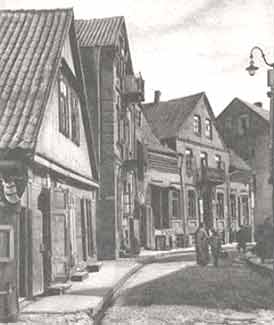

|
|
 The muddy street and wood construction of the houses are a common denominator in shtetl residential areas throughout the region from which most of our ancestors and their spouses came. This 1916 street scene of Iwanowo is of particular interest for its attempts at street drainage and home ventilation. The troughs alongside the houses were there to prevent flooding. A large section of roof fabricated so that could be propped up in good weather made possible an airing out of the entire house. Iwanowo is 147.4 miles southwest of Minsk. |
|
|
|
Two sons of Lazar Elia Uberstine were in the barrel business before they came to America, and again successful after transplanting themselves here: Harris Uberstine in Canton, Ohio, and his youngest brother to come to America, Israel Rubenstein of Trenton, New Jersey. (He is not to be confused with Israel Rubenstein, Usher Uberstine's second oldest son who came to America). |
|
|
|
|
 
On the back of Usher Uberstine's portrait,
Minsk photographer advertised
his studio. |
|
|
||
|
|
||
 This
is Bialystok, a street scene in the old Jewish section. Across from
the street light is a Jewish Synagogue. This
is Bialystok, a street scene in the old Jewish section. Across from
the street light is a Jewish Synagogue.Bialystok is known for its distinctive version of the bagel, which has been flattened, topped with browned onions and coarse salt, and nicknamed "The bialy." Bialystok is the name Mel Brooks gave his character, the show business eccentric, in his runaway Broadway hit, "The Producers." And Bialystok is forever linked to some of the worst pogroms on record. Another postcard view of Bialystok shows a parade in progress, and the explanatory material reveals that a major pogrom began later that day. *The pogroms from 1905 to 1906 were reported in the 1906 to 1907 American Jewish Year Book, available for reference in the library at the Center for Jewish History. "The figures frightfully arrayed are so heart- rending," says the introduction, "that one is impelled to apologize for perpetuating them." On January 26, 1905, in Gomel, Mogilev, which had a population of 46,446, of which 26,161 were Jews, "Police assisted the hooligans, and soldiers led by the police commissioner fired on the Jews." On January 31, 1905, in Vasilikov, Kiev, "Every Jewish shop and house was plundered and burnt." In Posin, Vitebsk, in June, 1905, "Soldiers broke into a synagogue during a service, and many Jews were killed and injured." On November 3, 1905, in Orsha, Mohilev, which had a population of 13,161, of which 7,000 were Jews, the shops of 30 Jews were destroyed and they "were killed before the police and soldiers; the mob demanded five rubles head money for each, but the police bid them to be content with the loot." On November 4, 1905, in Biela Tserkov, Kiev, which had a population of 22,708 of which 9,000 were Jews, "almost all the Jewish houses were looted and demolished," and there were "many killed and wounded" in this "riot openly directed by the police." On October 31, 1905, in Odessa, which had a population of 405,041 of which 160,000 were Jews, over 800 were killed and 5,000 wounded. And on the same day in Kiev, there were 60 killed and 369 wounded. Seven thousand families suffered, and 2,000 shops were looted. "The self-defense was heroic, almost all the killed and wounded were of the self-defense league." During the pogroms of November 1905, the Year Book states that 25,000 Jews were killed, 100,000 were injured, 200,000 families were ruined, and 400 million rubles was the cost. This feature, with a "Table created by Mr. J. Roschovsky," is entitled, "From Kishineff to Bialystok: A table of Pogroms from 1903 to 1906." The next feature was a "Report of the Duma Commission on the Bialystok Massacre," but I could read no more. |
||
|
|
||
|
About these postcards: Tomasz Wisniewski has long offered postcards for sale over the internet from his enormous collection. However, it wasn't until the genealogical publisher, Gary Mokotoff of Avotaynu, came along, that they became accessible. At http://www.avotaynu.com/postcards/index.html, you make a selection, pay by credit card, and receive in an e-mail attachment the next day your large JPGs. "By scanning the originals, we can offer you images for only $2.50 apiece [$10 minimum]," Mokotoff says. "You can then print the images on a color printer or include them on a Web page." Winnowing our selection to those above took days and days. |
||
![]()